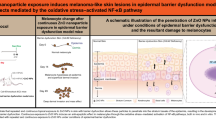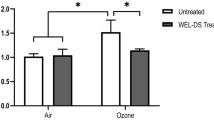Abstract
Titanium dioxide nanoparticles (TiO2NPs) are used in sunscreen products to protect the skin from the sun’s ultraviolet rays. However, following exposure to sunlight, the photocatalytic activity of TiO2NPs can produce an excess of reactive oxygen species (ROS), causing skin cell damage, triggering an inflammatory response. In zebrafish model, we evaluated how well Pro-NP™ (biodegradable NPs containing superoxide dismutase and catalase) could protect them from TiO2NP-induced photo-oxidative stress. We hypothesized that the antioxidant properties of Pro-NP™ would protect zebrafish embryos from the phototoxic effects of TiO2NPs, improving overall survival and growth. Dechorionated embryos were treated with TiO2NPs alone or co-treated with Pro-NP™, and then exposed to simulated sunlight. Pro-NP™ by itself caused no toxicity; however, for embryos exposed to 100 μg/ml TiO2NPs, zebrafish survival was reduced to ∼40% and at 500 μg/ml to ∼10%. In contrast, at 100 μg/ml TiO2NP, co-treatment with Pro-NP™ increased zebrafish survival in a dose-dependent manner. Co-treatment also improved percent of embryos hatching and resulted in normal growth of zebrafish. On the other hand, embryos treated with TiO2NPs alone developed deformities, had reduced pigmentation, and showed severely truncated growth. Pro-NP™ afforded a greater level of protection against TiO2NP-induced phototoxicity than other antioxidants (vitamin E or N-acetylcysteine) commonly used in topical skin care formulations. We conclude that Pro-NP™ exert significant protective effects against TiO2NP-induced phototoxicity and could be developed as a safe, effective skin care product, used alone or in combination with sunscreen products to protect the skin from sun’s UV radiation.








Similar content being viewed by others
References
Smijs TG, Pavel S. Titanium dioxide and zinc oxide nanoparticles in sunscreens: focus on their safety and effectiveness. Nanotechnol Sci Appl. 2011;4:95–112. doi:10.2147/NSA.S19419.
Jansen R, Wang SQ, Burnett M, Osterwalder U, Lim HW. Photoprotection: part I. Photoprotection by naturally occurring, physical, and systemic agents. J Am Acad Dermatol. 2013a;69(6):853. doi:10.1016/j.jaad.2013.08.021.e1-12; quiz 65-6
Gallagher RP, Lee TK, Bajdik CD, Borugian M. Ultraviolet radiation. Chronic Dis Can. 2010;29(Suppl 1):51–68.
Schwarz T, Schwarz A. Molecular mechanisms of ultraviolet radiation-induced immunosuppression. Eur J Cell Biol. 2011;90(6–7):560–4. doi:10.1016/j.ejcb.2010.09.011.
Granstein RD, Matsui MS. UV radiation-induced immunosuppression and skin cancer. Cutis. 2004;74(5 Suppl):4–9.
Sklar LR, Almutawa F, Lim HW, Hamzavi I. Effects of ultraviolet radiation, visible light, and infrared radiation on erythema and pigmentation: a review. Photochem Photobiol Sci. 2013;12(1):54–64. doi:10.1039/c2pp25152c.
Popov AP, Zvyagin AV, Lademann J, Roberts MS, Sanchez W, Priezzhev AV, et al. Designing inorganic light-protective skin nanotechnology products. J Biomed Nanotechnol. 2010;6(5):432–51.
Kullavanijaya P, Lim HW. Photoprotection. J Am Acad Dermatol. 2005;52(6):937–58. quiz 59-62 doi:10.1016/j.jaad.2004.07.063.
Sambandan DR, Ratner D. Sunscreens: an overview and update. J Am Acad Dermatol. 2011;64(4):748–58. doi:10.1016/j.jaad.2010.01.005.
Morabito K, Shapley NC, Steeley KG, Tripathi A. Review of sunscreen and the emergence of non-conventional absorbers and their applications in ultraviolet protection. Int J Cosmet Sci. 2011;33(5):385–90. doi:10.1111/j.1468-2494.2011.00654.x.
Zhuang R, Zabar R, Grbovic G, Dolenc D, Yao J, Tisler T, et al. Stability and toxicity of selected chlorinated benzophenone-type UV filters in waters. Acta Chim Slov. 2013;60(4):826–32.
Bunhu T, Kindness A, Martincigh BS. Determination of titanium dioxide in commercial sunscreens by inductively coupled plasma–optical emission spectrometry. S Afr J Chem. 2011;64:139–43.
Monteiro-Riviere NA, Wiench K, Landsiedel R, Schulte S, Inman AO, Riviere JE. Safety evaluation of sunscreen formulations containing titanium dioxide and zinc oxide nanoparticles in UVB sunburned skin: an in vitro and in vivo study. Toxicol Sci. 2011;123(1):264–80. doi:10.1093/toxsci/kfr148.
Jovanovic B. Review of titanium dioxide nanoparticle phototoxicity: developing a phototoxicity ratio to correct the endpoint values of toxicity tests. Environ Toxicol Chem. 2015;34(5):1070–7. doi:10.1002/etc.2891.
Saliou C, Kitazawa M, McLaughlin L, Yang JP, Lodge JK, Tetsuka T, et al. Antioxidants modulate acute solar ultraviolet radiation-induced NF-kappa-B activation in a human keratinocyte cell line. Free Radic Biol Med. 1999;26(1–2):174–83.
Pillai S, Oresajo C, Hayward J. Ultraviolet radiation and skin aging: roles of reactive oxygen species, inflammation and protease activation, and strategies for prevention of inflammation-induced matrix degradation - a review. Int J Cosmet Sci. 2005;27(1):17–34. doi:10.1111/j.1467-2494.2004.00241.x.
Liu Z, Zhang M, Han X, Xu H, Zhang B, Yu Q, et al. TiO2 nanoparticles cause cell damage independent of apoptosis and autophagy by impairing the ROS-scavenging system in Pichia Pastoris. Chem Biol Interact. 2016;252:9–18. doi:10.1016/j.cbi.2016.03.029.
Jansen R, Osterwalder U, Wang SQ, Burnett M, Lim HW. Photoprotection: part II. Sunscreen: development, efficacy, and controversies. J Am Acad Dermatol. 2013b;69(6):867. doi:10.1016/j.jaad.2013.08.022.e1-14; quiz 81-2
Sha B, Gao W, Cui X, Wang L, Xu F. The potential health challenges of TiO2 nanomaterials. J Appl Toxicol. 2015;35(10):1086–101. doi:10.1002/jat.3193.
Gasparro FP. Sunscreens, skin photobiology, and skin cancer: the need for UVA protection and evaluation of efficacy. Environ Health Perspect. 2000;108(Suppl 1):71–8.
Autier P. Sunscreen abuse for intentional sun exposure. Br J Dermatol. 2009;161(Suppl 3):40–5. doi:10.1111/j.1365-2133.2009.09448.x.
Poljsak B, Dahmane R. Free radicals and extrinsic skin aging. Dermatol Res Pract. 2012;2012:135206. doi:10.1155/2012/135206.
Leite-Silva VR, Le Lamer M, Sanchez WY, Liu DC, Sanchez WH, Morrow I, et al. The effect of formulation on the penetration of coated and uncoated zinc oxide nanoparticles into the viable epidermis of human skin in vivo. Eur J Pharm Biopharm. 2013;84(2):297–308. doi:10.1016/j.ejpb.2013.01.020.
Deng Y, Ediriwickrema A, Yang F, Lewis J, Girardi M, Saltzman WM. A sunblock based on bioadhesive nanoparticles. Nat Mater. 2015;14(12):1278–85. doi:10.1038/nmat4422.
Pan Z, Lee W, Slutsky L, Clark RA, Pernodet N, Rafailovich MH. Adverse effects of titanium dioxide nanoparticles on human dermal fibroblasts and how to protect cells. Small. 2009;5(4):511–20. doi:10.1002/smll.200800798.
Feng X, Zhang S, Lou X. Controlling silica coating thickness on TiO2 nanoparticles for effective photodynamic therapy. Colloids Surf B Biointerfaces. 2013;107:220–6. doi:10.1016/j.colsurfb.2013.02.007.
Veronovski N, Lesnik M, Lubej A, Verhovsek D. Surface treated titanium dioxide nanoparticles as inorganic UV filters in sunscreen products. Acta Chim Slov. 2014;61(3):595–600.
Garvas M, Testen A, Umek P, Gloter A, Koklic T, Strancar J. Protein corona prevents TiO2 phototoxicity. PLoS One. 2015;10(6):e0129577. doi:10.1371/journal.pone.0129577.
Ozmen M, Gungordu A, Erdemoglu S, Ozmen N, Asilturk M. Toxicological aspects of photocatalytic degradation of selected xenobiotics with nano-sized Mn-doped TiO2. Aquat Toxicol. 2015;165:144–53. doi:10.1016/j.aquatox.2015.05.020.
Siddhapara KS, Shah DV. Experimental study of transition metal ion doping on TiO2 with photocatalytic behavior. J Nanosci Nanotechnol. 2014;14(8):6337–41.
Manzo S, Buono S, Rametta G, Miglietta M, Schiavo S, Di Francia G. The diverse toxic effect of SiO (2) and TiO (2) nanoparticles toward the marine microalgae Dunaliella tertiolecta. Environ Sci Pollut Res Int. 2015;22(20):15941–51. doi:10.1007/s11356-015-4790-2.
Brezova V, Gabcova S, Dvoranova D, Stasko A. Reactive oxygen species produced upon photoexcitation of sunscreens containing titanium dioxide (an EPR study). J Photochem Photobiol B. 2005;79(2):121–34. doi:10.1016/j.jphotobiol.2004.12.006.
Chakraborty C, Sharma AR, Sharma G, Lee SS. Zebrafish: a complete animal model to enumerate the nanoparticle toxicity. J Nanobiotechnol. 2016;14(1):65. doi:10.1186/s12951-016-0217-6.
Clemente Z, Castro VL, Moura MA, Jonsson CM, Fraceto LF. Toxicity assessment of TiO (2) nanoparticles in zebrafish embryos under different exposure conditions. Aquat Toxicol. 2014;147:129–39. doi:10.1016/j.aquatox.2013.12.024.
Xiong D, Fang T, Yu L, Sima X, Zhu W. Effects of nano-scale TiO2, ZnO and their bulk counterparts on zebrafish: acute toxicity, oxidative stress and oxidative damage. Sci Total Environ. 2011;409(8):1444–52. doi:10.1016/j.scitotenv.2011.01.015.
Dunford R, Salinaro A, Cai L, Serpone N, Horikoshi S, Hidaka H, et al. Chemical oxidation and DNA damage catalysed by inorganic sunscreen ingredients. FEBS Lett. 1997;418(1–2):87–90.
Bar-Ilan O, Louis KM, Yang SP, Pedersen JA, Hamers RJ, Peterson RE, et al. Titanium dioxide nanoparticles produce phototoxicity in the developing zebrafish. Nanotoxicology. 2012;6(6):670–9. doi:10.3109/17435390.2011.604438.
Gali NK, Ning Z, Daoud W, Brimblecombe P. Investigation on the mechanism of non-photocatalytically TiO2 -induced reactive oxygen species and its significance on cell cycle and morphology. J Appl Toxicol. 2016;36(10):1355–63. doi:10.1002/jat.3341.
Wu J, Liu W, Xue C, Zhou S, Lan F, Bi L, et al. Toxicity and penetration of TiO2 nanoparticles in hairless mice and porcine skin after subchronic dermal exposure. Toxicol Lett. 2009;191(1):1–8. doi:10.1016/j.toxlet.2009.05.020.
Ananthaswamy HN, Pierceall WE. Molecular mechanisms of ultraviolet radiation carcinogenesis. Photochem Photobiol. 1990;52(6):1119–36.
Reddy MK, Wu L, Kou W, Ghorpade A, Labhasetwar V. Superoxide dismutase-loaded PLGA nanoparticles protect cultured human neurons under oxidative stress. Appl Biochem Biotechnol. 2008;151(2–3):565–77. doi:10.1007/s12010-008-8232-1.
Singhal A, Morris VB, Labhasetwar V, Ghorpade A. Nanoparticle-mediated catalase delivery protects human neurons from oxidative stress. Cell Death Dis. 2013;4:e903. doi:10.1038/cddis.2013.362.
Chen L, Hu JY, Wang SQ. The role of antioxidants in photoprotection: a critical review. J Am Acad Dermatol. 2012;67(5):1013–24. doi:10.1016/j.jaad.2012.02.009.
Wang SQ, Osterwalder U, Jung K. Ex vivo evaluation of radical sun protection factor in popular sunscreens with antioxidants. J Am Acad Dermatol. 2011;65(3):525–30. doi:10.1016/j.jaad.2010.07.009.
Paterson G, Ataria JM, Hogue ME, Burns DC, Metcalfe CD. The toxicity of titanium dioxide nanopowder to early life stages of the Japanese medaka (Oryzias latipes). Chemosphere. 2011;82(7):1002–9. doi:10.1016/j.chemosphere.2010.10.068.
Samaee SM, Rabbani S, Jovanovic B, Mohajeri-Tehrani MR, Haghpanah V. Efficacy of the hatching event in assessing the embryo toxicity of the nano-sized TiO2 particles in zebrafish: a comparison between two different classes of hatching-derived variables. Ecotoxicol Environ Saf. 2015;116:121–8. doi:10.1016/j.ecoenv.2015.03.012.
Stees M, Adjei I, Labhasetwar V. A method for quantification of penetration of nanoparticles through skin layers using near-infrared optical imaging. Cosmetics. 2015;2:225–35.
Moan J, Grigalavicius M, Baturaite Z, Dahlback A, Juzeniene A. The relationship between UV exposure and incidence of skin cancer. Photodermatol Photoimmunol Photomed. 2015;31(1):26–35. doi:10.1111/phpp.12139.
Pandel R, Poljsak B, Godic A, Dahmane R. Skin photoaging and the role of antioxidants in its prevention. ISRN Dermatol. 2013;2013:930164. doi:10.1155/2013/930164.
Author information
Authors and Affiliations
Contributions
MK conducted the experiments; MS formulated Pro-NP™; MK and BK compiled data and prepared the initial manuscript draft; SV carried out UV absorption of Pro-NP™ and particle size characterization; RP, GM, VL designed and supervised the study; and VL compiled final data and wrote the manuscript with contributions from co-authors. Authors reviewed the manuscript prior to submission.
Corresponding author
Ethics declarations
Conflict of interest
The study was funded by ProTransit Nanotherapy, LLC, Omaha, NE, a start-up company based on patented work done at the University of Nebraska Medical Center. GM and VL are co-founders of ProTransit Nanotherapy and have an equity interest in the company. ProTransit can make Pro-NP™ available to potential investigators under material transfer agreement. Potential conflict of interest matters for VL are managed according to guidelines of the Conflict of Interest committee of Cleveland Clinic.
Ethical statement
The use of zebrafish and maintenance plan were approved by the Research Animal Resources Center of the University of Wisconsin-Madison.
Rights and permissions
About this article
Cite this article
Kim, MS., Stees, M., Karuturi, B.V.K. et al. Pro-NP™ protect against TiO2 nanoparticle-induced phototoxicity in zebrafish model: exploring potential application for skin care. Drug Deliv. and Transl. Res. 7, 372–382 (2017). https://doi.org/10.1007/s13346-017-0374-7
Published:
Issue Date:
DOI: https://doi.org/10.1007/s13346-017-0374-7




